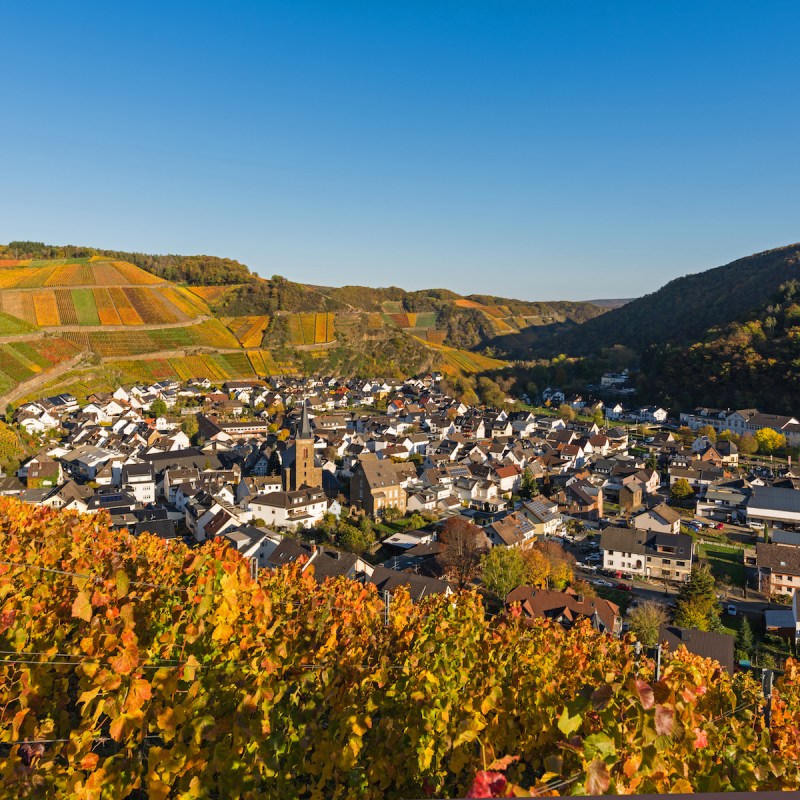
Fall is grape harvest time in Germany. There are 13 regions where wine is grown, the same number as in France. The regions are located mostly in the southern part of Germany and along the rivers Rhine, Mosel, and Ahr. Soil as well as climate favor the ripening of the grapes, white as well as red, and give German wines their much-coveted flavor and quality. It was the Romans who brought the first grapes to Germany when they conquered the region some 2,000 years ago and, apparently, found it too difficult to bring heavy amphoras with them across the Alps. They were lucky because the grapes took to the local conditions of their newly established province, Germania.
Videos by TravelAwaits
It was Emperor Charlemagne, however, who in the 8th century regulated the whole wine growing and marketing business, the center of which were mostly monasteries. You can visit the best wine-tasting destinations year-round, but fall is especially appealing because it often coincides with wine harvest festivals. The regions we take you to aren’t only best known for the quality of the wine but also for their history, traditional wineries, and beautiful landscapes with the leaves just turning colors.

1. Nierstein In Rhine-Hesse
Rhine-Hesse is the largest of the German wine-growing regions. Located on the west bank of the Rhine, it’s part of the larger region known as Rhineland-Palatinate. The landscape is covered with hills on which many vineyards are found. The largest city is Mainz with the international airport in Frankfurt only about 30 minutes away.
The grapes that grow here are mostly white, Riesling for example, and the best known wine outside Germany is Liebfraumilch. The best wine-tasting locations are in the lovely towns of Nierstein and Oppenheim. Combine history with fine wine on the first stop on your wine tasting tour of Rhine-Hesse at the oldest vineyard site in Germany, Niersteiner Glock. Of course, you want to try Niersteiner Domtal, too, so the next stop could be Weingut Staiger.
Oppenheim is home to the German Wine Museum, which documents wine-growing history from Roman times. The best known wine is Oppenheimer Kroetenbrunnen, and you must stop at the vineyard of the same name and try its wines.
Pro Tips: Learn a few German words: vinery is Weingut, wine tastings are weinprobe, and the winegrowers are winzer.

2. Frankfurt’s Sachsenhausen District
As you are so close to Frankfurt, you may as well take a few hours and visit the district of Sachsenhausen, south of the river Mainz. Sachsenhausen is famous for a great variety of cider bars and pubs, as cider or Applewoi (Applewine) is the standard drink in Frankfurt. Frankfurt is located in Hesse, and there are many other vineyards too, but you know the saying: “When in Rome …”
So, have your tasting of the best cider in one of the oldest and most original of the cider bars: Zum gemalten Haus.

3. Bernkastel & Cochem On The Banks Of The Mosel
The River Mosel is a very winding river that empties into the Rhine. The river valley is lined with vineyard after vineyard, often very steep and terraced. Cultivated since Roman times, the wines produced here come mainly from the Riesling grape and are sold in distinctive slim, dark green bottles. Mosel wines are rather low in alcohol, with high acidity and fruity undertones.
The Mosel winds like a snake and with the steep, wine-covered slopes and medieval towns and villages surrounding it, it is one of the prettiest parts of Germany to visit in the fall. Cochem, a medieval city that straddles the river, proves my point. There is the majestic Reichsberg castle, half-timbered houses, and city gates that date from 1332. Of course, we are interested in wine tastings, which can be enjoyed at H.H. Hieronimi. Or you can visit the vineyard Juffermauer located in Treis-Karden for a superb Riesling.
Idyllic Bernkastel-Kues is another gem of the Mosel region. The medieval town center and the 9th-century Landshut castle invite you for a visit before you go on a very original wine tasting tour: Doctor Wine Tour. Legend has it that the owner of the vineyard gave it to the ill Elector Bohemond II in the 14th century who was healed after consuming two glasses of the golden wine.

4. Bad Neuenahr In The Ahr Valley
The Ahr is a tributary to the Rhine. Although small, the Ahr region is Germany’s largest producer of red wines, mostly made from pinot noir grapes (Spatburgunder). Bad Neuenahr-Ahrweiler is a spa town sitting among the hills of the Ahr valley. Apart from the spa treatments, Bad Neuenahr also features a lively casino.
If you’d rather stick to wine tastings, visit the Weingut Sonnenberg at the end of the Ahr Wine trail right in Bad Neuenahr. Family owned and run, you can taste their Grauburgunders, Fruehburgunders, or Spaetburgunders to your heart’s content. Another winery is located in the town of Dernau. It’s called H.J.Naekle Kreuzberg and has been badly damaged by recent floods. However, it’s recovering and will soon be open for wine tastings again.

5. Wurzburg & Volkach In Franconia
The Franconia wine-growing region stretches along the River Main. More than 80 percent of the wine produced here is white, and the most prominent wines are Silvaner, Muller-Thurgau, and a local specialty called Bacchus. Franconia wines are easily recognizable because of the flattened, ellipsoid shape of the bottles, called Bocksbeutel. The center of the wine region is the beautiful baroque city of Wurzburg located on both sides of the River Main. It’s home to a UNESCO Heritage Site, the Residenz, the Marienburg Fortress, and the old Main bridge. Wurzburg’s oldest and most famous vineyard is the Wurzburger Stein. Steep and south-facing, it’s protected from the winds by a forest belt on the top. This vineyard produced the world’s oldest-known white wine, a 1540 vintage of Steinwein. Only one bottle remains intact, which you can see (but definitely not taste) on a cellar tour of the Buergerspital. Steinweiss is still produced at the Stein vineyard, so you can taste how good they are on a visit. An anecdote: Wines from this vineyard were the favorites of German writer Goethe.
The medieval town of Volkach is another wine tasting destination, with a wine festival, old city gates, and a pilgrimage church dating from the 1300s. A local specialty that you can taste at the festival or during fall after the harvest is Federweisser, the new wine. A winery you don’t want to miss is Winery Max Muller, now run by Christian Muller. His Silvaner is one of a kind. Christian even has his passion for Silvaner tattooed on his forearm!

6. Bad Dürkheim & Deidesheim In Pfalz
The Pfalz is part of Rhineland-Palatinate and Germany’s second-largest wine-growing region. Most notable here is the world’s largest wine festival in Bad Dürkheim, annually held 2 weekends in September. You may have missed it this year, but not to worry, there is the 53-mile-long Deutsche Weinstrasse, the famous wine route, established in 1935. It starts at the French border and ends at the House of the German Wine route in Bockenheim. The Pfalz is one of the warmest regions in Germany and not only known for growing wine but also for almond trees. Fall is the best time to visit the wineries in the Pfalz — which there are too many to list. With all your tastings, you’ll get used to a special glass used for wine drinking in the Pfalz: it holds 50cl, opens up toward the top, and has dimples, which are very handy to hold the glass when you have had a few. They are called Dubbeglass.
Riesling, pinot blanc, pinot gris, and gewurztraminer (all white wines) make up the majority of wine making in the Pfalz. But, recently, red wine production has also become important, like the fresh Weissherbst. Bad Dürkheim is a lovely spa town with many vinotheques where you can taste all types of Pfalz wines. Deidesheim is a small but prestigious village of local viniculture. Just north of the town center, make a stop at Kalkofen. It was once a lime kiln!

7. Heilbronn In Württemberg
Located along the River Neckar, Württemberg is red wine country. It’s Germany’s premier red wine producer. It is said that the locals consume more wine here than anywhere else in Germany, and they are especially fond of Trollinger or their rose called Schillerwein. The largest cities are Stuttgart (with an international airport) and Heilbronn. The vineyards along the Neckar Valley are steep and terraced and can only be tended by hand.
Heilbronn is known as the wine capital of Württemberg. Located on both banks of the river Neckar there are several sites worth visiting, like the Bollwerk Turm, the Gietzen Turm, Si Kilian Church, and the astronomical clock in the town hall tower.
Living up to its reputation, Heilbronn is the location of the great Weingut Rolf Heinrich, where you can taste all the above-mentioned wines plus Lemberger, another local wine. Taste and buy all the great Württemberg wines at the Winery Württemberg.
Visit Germany any time of the year for great vacation experiences:
